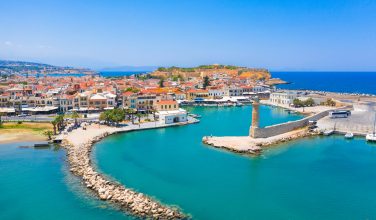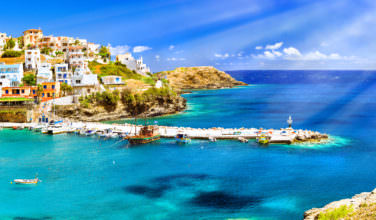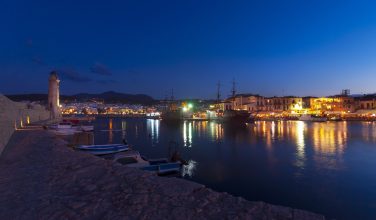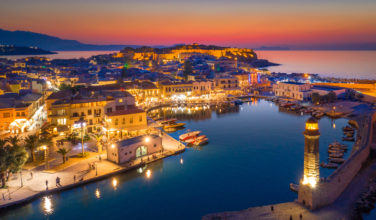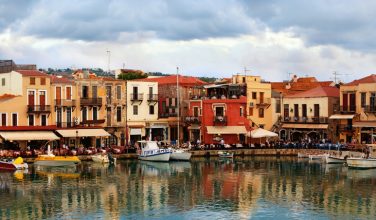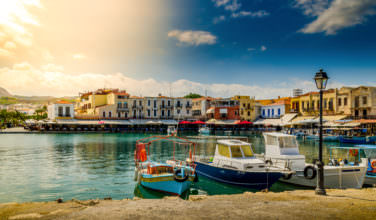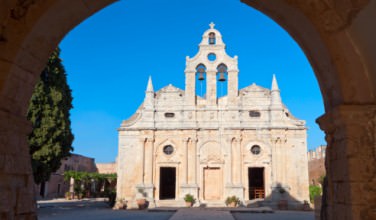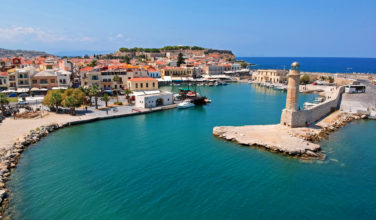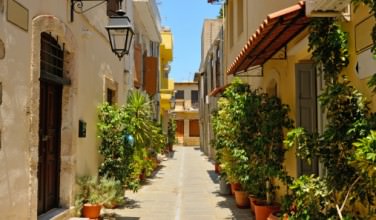Rethymno is a city on the island of Crete. It is located between Chania and Heraklion and has the Cretan Sea to the north and the Libyan Sea to the 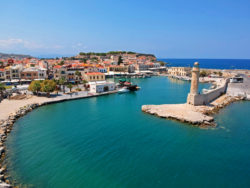 south. The highest peak of Rethymno is Mount Vrysina at 858 meters. A mountain range rises over the town, mostly to the south. The area also consists of small rivers, gorges, caves, and lots of greenery.
south. The highest peak of Rethymno is Mount Vrysina at 858 meters. A mountain range rises over the town, mostly to the south. The area also consists of small rivers, gorges, caves, and lots of greenery.
The history of Rethymno goes back to the Neolithic years. Archaeological findings from this time include signs, writings of ancient historians, and coins. During the 12th and 11th century BC, the Minoan civilization flourished in trade and made their mark on the area with their culture. The most important Minoan town in Rethymno was Ancient Eleftherna, but sadly an eruption of Santorini volcano bring this to an end.
The city of Rethymno would begin to flourish in the early 16th century. The city would be rebuilt by the Venetians, which led to the Cretan Renaissance. This gold period of arts and letters is only seen in Crete and the Ionian Islands. Scientists and other intellectuals would flock to Rethymno. A public library and literary societies were established as well. In 1669, this cultural era would begin to greatly decline when the Turks conquered Crete. The locals would fight against the Turks, but there would be a great loss of life. In 1913, Rethymno, along with the rest of Crete, was united with the Greek state.
Rethymno Town is well-known for its boutique hotels, guesthouses, and luxurious resorts. It is a well-preserved town that retains its elegant buildings, arched passages, Byzantine monuments, fountains, clock towers, and narrow alleys. The Venetian Loggia is an impressive example of architecture in the city. The 16th century building stands in the center of the Old Town of Rethymno.
Administrative Region of Rethymno, Greece
Crete
Area of Rethymno, Greece
396.3 km2 (153.0 sq mi)
Population of Rethymno, Greece
55,525
Top Attractions in Rethymno, Greece
Ibrahim Han Mosque – Located in town in the middle of the Venetian Fortezza. Originally built in 1580 as a Venetian cathedral, in 1646 it was converted into an Ottoman mosque. The building is square with a dome that is 11 meters.
Archaeological Museum – Located in town at the entrance of the Fortezza. This museum houses exhibits from excavations in the area. Findings from the Late Neolithic and Proto-Minoan times to the late Roman period include: tools, figurines, coins, helmets, weapons, marble statues, and more.
Ecclesiastical Museum – Located in town. The Ecclesiastical Museum is housed in the Cathedral. Rare items such as sacred utensils, religious objects, and priest vestments are showcased here.
Historical and Folklore Museum – Established in 1973, the museum is housed in a Venetian building in town. Exhibits include: coins, jewelry, tool, and traditional clothing. There are five rooms showcasing items from the 17th century to modern times.
Perivolia Beach – 2 km east of Rethymno Town. Its close proximity to town makes this beach popular. Aside from being a beautiful beach, it features water sports, sun beds and umbrellas, entertainment nearby, food and drink on site, and bars in the area.
Ideon Cave – The road to Ideon Cave is scenic with tall rock formations and mountains. The main entrance of the cave opens into a large chamber consisting of two horizontal caverns. Greek mythology says that baby Zeus was hidden here to protect him and he was fostered by goat-herd nymph Amaltheia.
The Fortezza of Rethymno – This Venetian castle sits on top of a hill above Rethymno Town. The castle was built between 1540 – 1570. Inside the Fortezza you can see many things including the Bastion of Santa Maria and the Agios Theodoros Trichinas Church.
Platanias Beach – 4 km from Town and accessible by bus. This is a well-organized beach with accommodations nearby. Taverns on site allow you to eat seaside while enjoying local cuisine.
Ottoman Baths – Also known as Hamams, these Ottoman baths are found in the Old Town. They date from 1670 and feature marble floors and high windows. While the baths are not open to the public, the building construction and architecture is not to be missed.
Rimondi Fountain – Built in 1626, the fountain can be seen in Petichaki Square in the Old Town. The fountain was named after the Venetian governor at the time. Three lions heads served as springs that provided that fountain with water and was an important source of water for residents.


